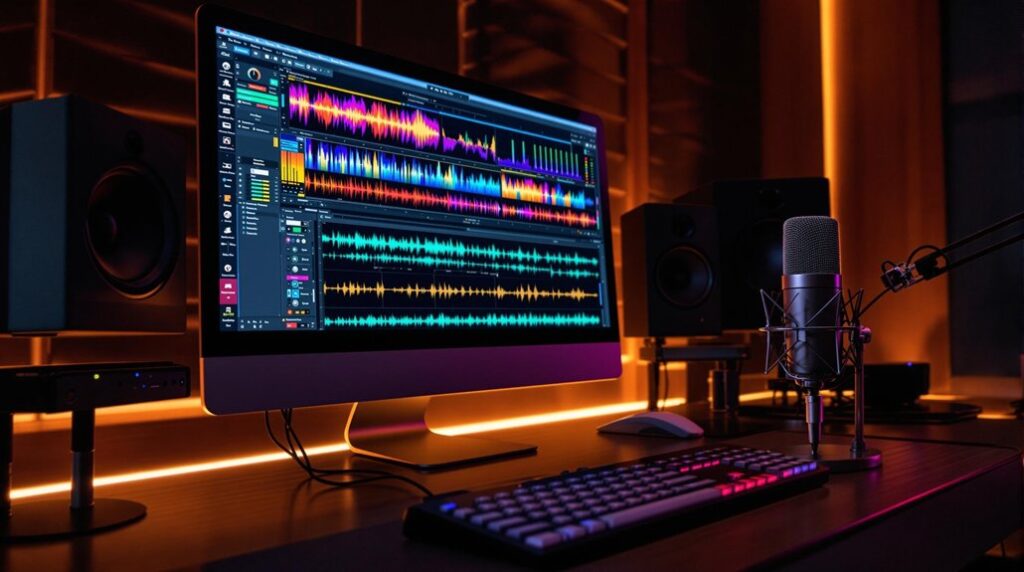Mastering Beat Detective in Pro Tools requires understanding its robust features for drum editing and rhythm correction. Start by setting your tempo correctly, then segment audio clips for precise timing adjustments. Utilize features like Groove Template Extraction to maintain rhythmic consistency across tracks. The tool's automatic tempo mapping guarantees seamless alignment with session grids. In Clip Separation mode, isolate and adjust sections without losing audio integrity. Edit Smoothing techniques help eliminate gaps and changes, enhancing overall sound quality. Calibration and sensitivity settings are crucial for accurate transient detection. With strategic application, these techniques streamline your editing workflow considerably.
Key Takeaways
- Access Beat Detective via the Event menu to start timing adjustments in Pro Tools.
- Configure detection parameters like Threshold and Sensitivity for accurate transient detection.
- Use Edit Smoothing to fill gaps and ensure smooth audio transitions.
- Extract Groove Templates to maintain consistent rhythmic patterns across tracks.
- Employ Clip Separation and Conform Clip Mode to resolve timing issues effectively.
Overview of Beat Detective
Beat Detective is a sophisticated drum editing tool integrated within Pro Tools, tailored for aligning audio clips that possess distinct transients, with a primary focus on drum tracks.
Designed to address timing issues, this editing tool excels at dissecting audio clips into smaller, manageable segments, facilitating precise timing adjustments without altering the audio's integrity.
By automatically generating bar and beat markers, Beat Detective creates an accurate tempo map for recordings, ensuring synchronization with the session tempo.
In addition, it can analyze audio to extract Groove Templates, which can be applied to other clips, promoting consistency across tracks.
While mastering its functionality requires practice, Beat Detective considerably enhances editing efficiency, elevating the overall quality of music production in Pro Tools. The tool's integration with Elastic Audio allows for seamless manipulation of audio timing, further enhancing its utility in complex editing scenarios.
Key Features and Functions
Pro Tools' Beat Detective boasts a suite of robust features designed to streamline the editing process for rhythmic audio tracks.
Central to its capabilities is the automatic generation of a tempo map, which aligns audio tracks to the session grid, even without a click track. This facilitates precise timing adjustments and enhances the overall rhythmic integrity of a Pro Tools session.
Key features include:
- Groove Template Extraction: Analyze one clip's timing and apply its groove to other clips, ensuring consistent rhythmic elements across parts.
- Separate Audio and Clip Conform: Detect transients to separate audio into clips, which are then aligned using adjustable quantization parameters.
- Edit Smoothing: Enhance audio continuity by trimming and crossfading, eliminating gaps and ensuring smooth shifts.
Initial Setup and Configuration
To effectively harness the full potential of Beat Detective, an initial setup and configuration of your Pro Tools session is essential.
Begin by setting the correct tempo through MIDI controls or the Tempo track to align with the original performance. Import audio tracks, ensuring they are clean and stable, and make precise selections of regions to analyze.
Access Beat Detective via the Event menu, selecting tasks like Adjust Timing or Create Groove Template.
Critical to this process is configuring detection parameters: adjust Threshold, Sensitivity, and Clip Separation within the Selection box to accurately detect transients.
Familiarize yourself with modes such as Normal Detection and Collection Mode to refine your audio analysis and editing workflow, ensuring a precise and efficient editing process. Ensure that the Hardware Buffer Size is appropriately set to prevent latency and provide stability during the editing process.
Rhythm Analysis Techniques
After establishing a solid foundation through initial setup and configuration, attention turns to rhythm analysis techniques, a vital aspect of mastering Beat Detective. This process involves detecting transients in audio recordings to identify beats and timing discrepancies.
Adjusting sensitivity settings optimizes transient detection, ensuring only pertinent rhythmic information is captured. The detection window allows tailored analysis via High or Low Emphasis, essential for timing accuracy. Captured selections facilitate tempo map creation, aligning audio with the session grid without altering original quality. Pro Tools offers two fundamental editing modes, Grid Mode and Slip Mode, which are essential for achieving precise edits and ensuring rhythmic accuracy.
Key techniques include:
- Transient Detection: Analyze clips for transients to identify timing issues.
- Sensitivity Adjustment: Fine-tune settings to improve transient identification.
- Groove Template Extraction: Extract rhythm from clips to apply consistent timing across audio recordings.
Clip Separation and Conform
Explore Clip Separation and Conform, a crucial phase in refining rhythm precision using Beat Detective.
Clip Separation enables precise timing adjustments by segmenting audio tracks at detected transients. By fine-tuning sensitivity settings, users can guarantee accurate transient capture, which is fundamental for effective separation.
Post-separation, the Conform function quantizes these segments to the session's grid, aligning them perfectly with the desired rhythmic pattern. This process is essential for maintaining musicality while achieving precise timing.
Edit Smoothing can subsequently enhance fluidity by trimming gaps and applying crossfades between clips. The Fade Command in Pro Tools allows users to apply specific parameters for fade duration and shape, ensuring smooth transitions and a polished final product.
It is imperative to review and listen to the result after Clip Separation and Conform to verify that the edits reflect the original performance's intent and musicality, guaranteeing a seamless audio experience.
Smoothing and Refinement
With the Clip Separation and Conform phase complete, attention shifts to the Smoothing and Refinement process, which plays a vital role in enhancing audio continuity.
In Beat Detective, Edit Smoothing automatically fills gaps between clips by trimming and implementing crossfades, ensuring seamless changes. This step is essential post-Clip Conform to address artifacts from the quantization process, thereby preventing timing issues and enhancing the final mix's professionalism.
Key considerations include:
- Customizable Crossfades: Users can adjust crossfade lengths to match specific audio material, achieving ideal smoothness.
- Consistency in Application: Applying Edit Smoothing after all major edits safeguards audio integrity.
- Professional Sound Quality: Regular use of Edit Smoothing minimizes abrupt audio changes, greatly improving the final mix's quality.
To further enhance your workflow, understanding signal flow in Pro Tools is essential, as it allows for precise control over audio routing and processing, which can significantly impact the quality of your final mix.
Practical Usage Tips
Mastery of Beat Detective's practical usage hinges on an understanding of its nuanced settings and features. In Pro Tools, addressing timing issues on audio tracks requires precise transient detection. Adjust the sensitivity settings to effectively capture transients while minimizing false triggers. Emphasize High for cymbals and Low for kick/toms to tailor transient detection. Clip Separation and Edit Smoothing are essential for resolving timing issues and providing a seamless edit. Always set the Timebase Selector to ticks before quantizing audio to align with the session's tempo grid. To maintain a human feel, utilize the Swing parameter during quantization. Regular practice will enhance your proficiency. Utilize tools like dynamic range compression to ensure even track levels and enhance musical expression without making the track sound lifeless.
| Feature | Purpose |
|---|---|
| High Emphasis | Optimize cymbal detection |
| Clip Separation | Resolve timing issues |
| Edit Smoothing | Streamline audio changes |
Advanced Editing Techniques
Steering through the intricacies of Pro Tools Beat Detective requires a deep understanding of its advanced editing techniques to achieve precise audio manipulation. Mastery begins with adjusting sensitivity settings to accurately detect transient trigger points, essential for aligning audio in the drum editing process. Careful calibration avoids false positives, enhancing workflow efficiency. Pro Tools playlists enable non-destructive editing for efficient take management, allowing seamless organization of multiple recordings for efficient take selection.
- Edit Smoothing: Seamlessly fill gaps and crossfade between clips, ensuring audio continuity and resolving timing issues without artifacts.
- Groove Template Extraction: Analyze rhythmic patterns to maintain a consistent groove across multiple tracks, critical for cohesive musicality.
- Conform Clip Mode: Quantize clips to the session grid, offering precise timing adjustments and preserving waveform integrity.
Utilize these tools in Beat Detective to refine the editing process, ensuring professional-level audio precision and cohesion.
Frequently Asked Questions
Is Pro Tools Good for Mastering?
Pro Tools excels in mastering by offering advanced audio editing and mastering plugins, supporting intricate mixing techniques, and facilitating professional-grade sound design. Its capabilities in vocal processing, drum programming, track arrangement, and DAW comparison make it ideal for thorough music production.
Conclusion
In summary, mastering Pro Tools Beat Detective requires a thorough understanding of its features and functions, including initial setup, rhythm analysis, and clip separation. The process involves meticulous configuration, precise rhythm analysis, and effective use of clip separation and conform tools. Smoothing and refinement enhance the quality of the final output, while advanced editing techniques provide greater control and flexibility. By adhering to these methodological steps, users can achieve professional-grade results efficiently and effectively in digital audio production.




